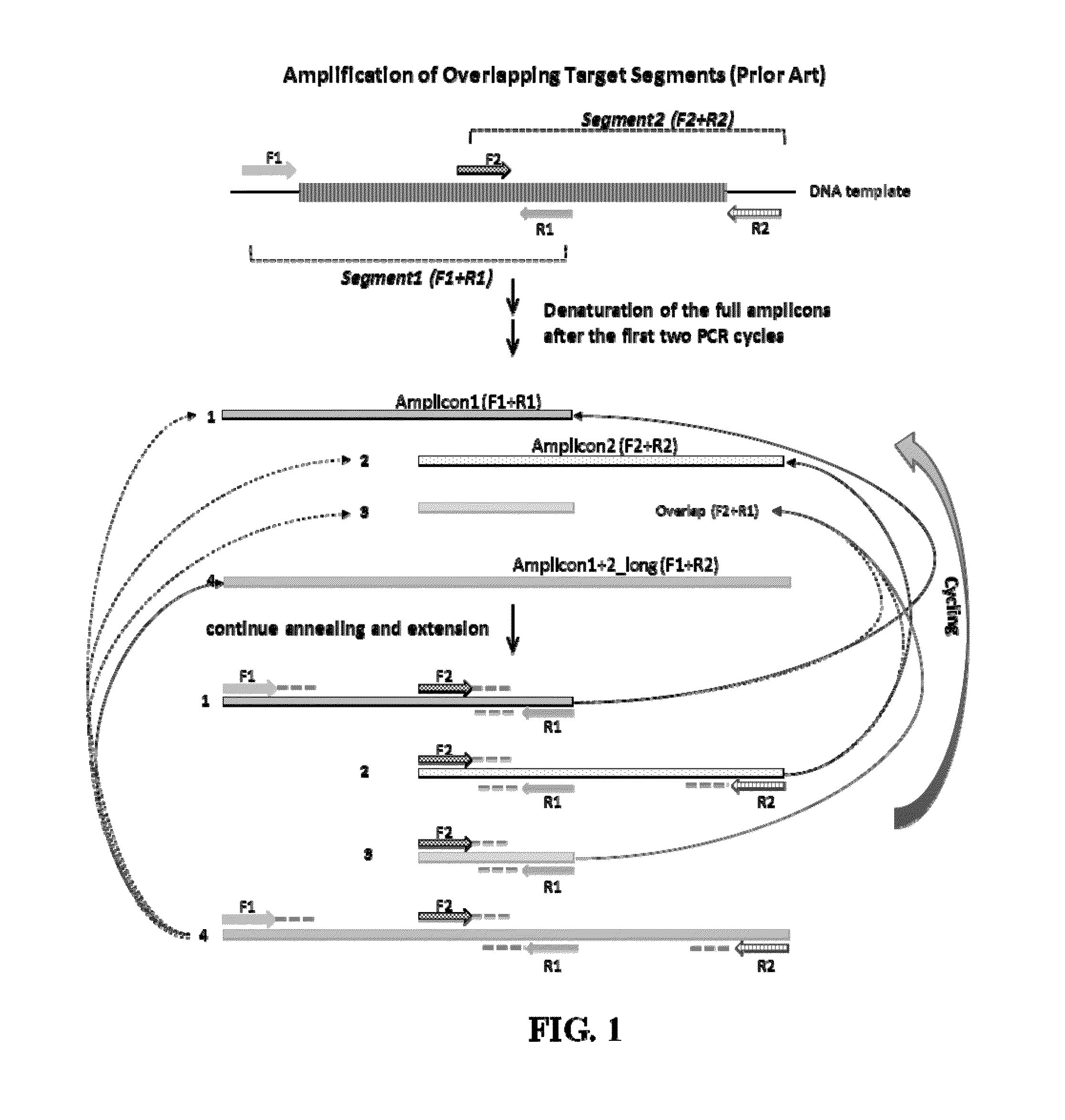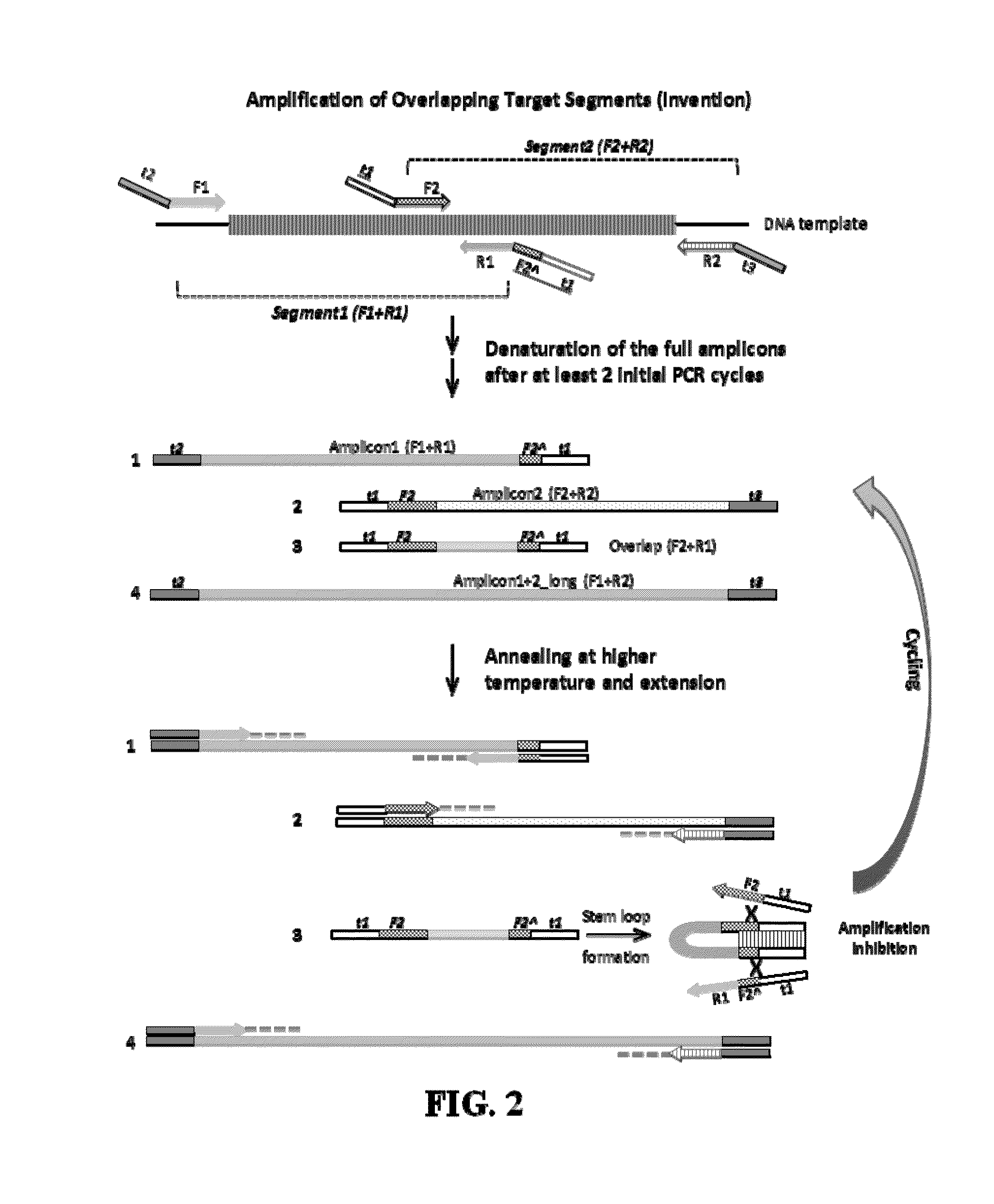Selective amplification of overlapping amplicons
a technology of overlapping amplicons and amplification, applied in the direction of microbiological testing/measurement, biochemistry apparatus and processes, etc., can solve the problems of increasing the cost of testing and complicating the workflow
- Summary
- Abstract
- Description
- Claims
- Application Information
AI Technical Summary
Benefits of technology
Problems solved by technology
Method used
Image
Examples
example 1
First Round of PCR Amplification (Gene-Specific Primers)
[0043]A representative PCR mixture of 25 μL included the following components: 12.5 μL of 2× Multiplex Master Mix (KAPA Biosystems, Cat#KK5802), 2 μL human genomic DNA (Promega, Cat#G3041) diluted to 5 ng / μL in low TE buffer (USB, Cat#75793), 6.5 μL nuclease-free water, and 4 μL of gene-specific primer mix (1.25 μEM each, see Multiplex Primer Mix Lanes 3-8 in Table 3).
[0044]The singleplex (FIG. 4, Lane 2) PCR, the standard multiplex (FIG. 4, Lane 3) PCR, and the stem-forming multiplex (FIG. 4, Lanes 4-8) PCR were all performed on a thermal cycler as follows:
1 cycle95° C. 2 minutesEnzyme activation andinitial DNA denaturation 5 cycles95° C.30 secondsDenaturation60° C.90 secondsAnnealing / extension30 cycles95° C.30 secondsDenaturation72° C.90 secondsAnnealing / extension atan increased temperature1 cycle72° C. 5 minutesFinal extension1 cycle 8° C.Hold
example 2
[0045]The products from example 1 were analyzed on an E-base device (Life Technologies). Two μL of the product was diluted to a final volume of 20 μL with nuclease-free water and loaded onto a 2% SizeSelect E-gel. DNA electrophoresis of diluted PCR products (Lanes 2-8) and 1 Kb Plus DNA ladder (Invitrogen, Cat#10488-090, Lane 1) was performed, and at the end of the run, a digital image of the gel was captured by an E-gel Imager (Life Technologies). Results are shown in FIG. 4.
[0046]In Lane 2 of FIG. 4, equal amounts of the products of singleplex reactions from Example 1 are mixed and can be seen together on the gel, designated Amplicons 1 and 2. Standard multiplex PCR predominantly produces Amplicon 3 (Lane 3), which is PCR product amplified from the overlap of Amplicons 1 and 2. Amplicon 4, the entire region covered by Amplicons 1 and 2, can faintly be seen in Lane 3. Lanes 4 and 5, which contain stem oligonucleotides of t1 only and t1 plus partial F2 (4 ...
example 3
First Round of Gene-specific PCR Amplification for BRCA2 exon 27 (B2X27)
[0049]A representative PCR mixture of 25 μL included the following components: 12.5 μL of 2× Multiplex Master Mix (KAPA Biosystems, Cat#KK5802), 6 uL of DNA (Coriell, Cat#NA19240 or NA14622) diluted to 5 ng / μL in low TE buffer (IDT, Cat#11-05-01-09), 2.5 μL nuclease-free water, and 4 μL of gene-specific primer mix (1.25 μM each).
[0050]The conventional primer mix contained the following six oligos from Table 4: SEQ ID NOs: 17 and 18 (B2X27 amplicon 1), 19 and 20 (B2X27 amplicon 2), and 21 and 22 (B2X27 amplicon 3). The SLIMAMP™ primer mix (the present invention) contains the following six oligos: 17 and 23 (B2X27 amplicon 1), 24 and 25 (B2X27 amplicon 2), and 21 and 22 (B2X27 amplicon 3).
[0051]The standard multiplex and stem-forming multiplex PCR is performed on a thermal cycler as follows:
1 cycle95° C.2 minutesEnzyme activation andinitial DNA denaturation 5 cycles95° C.15 seconds Denaturation60° C.6 minutesAnne...
PUM
| Property | Measurement | Unit |
|---|---|---|
| temperature | aaaaa | aaaaa |
| volume | aaaaa | aaaaa |
| volume | aaaaa | aaaaa |
Abstract
Description
Claims
Application Information
 Login to View More
Login to View More - R&D
- Intellectual Property
- Life Sciences
- Materials
- Tech Scout
- Unparalleled Data Quality
- Higher Quality Content
- 60% Fewer Hallucinations
Browse by: Latest US Patents, China's latest patents, Technical Efficacy Thesaurus, Application Domain, Technology Topic, Popular Technical Reports.
© 2025 PatSnap. All rights reserved.Legal|Privacy policy|Modern Slavery Act Transparency Statement|Sitemap|About US| Contact US: help@patsnap.com



